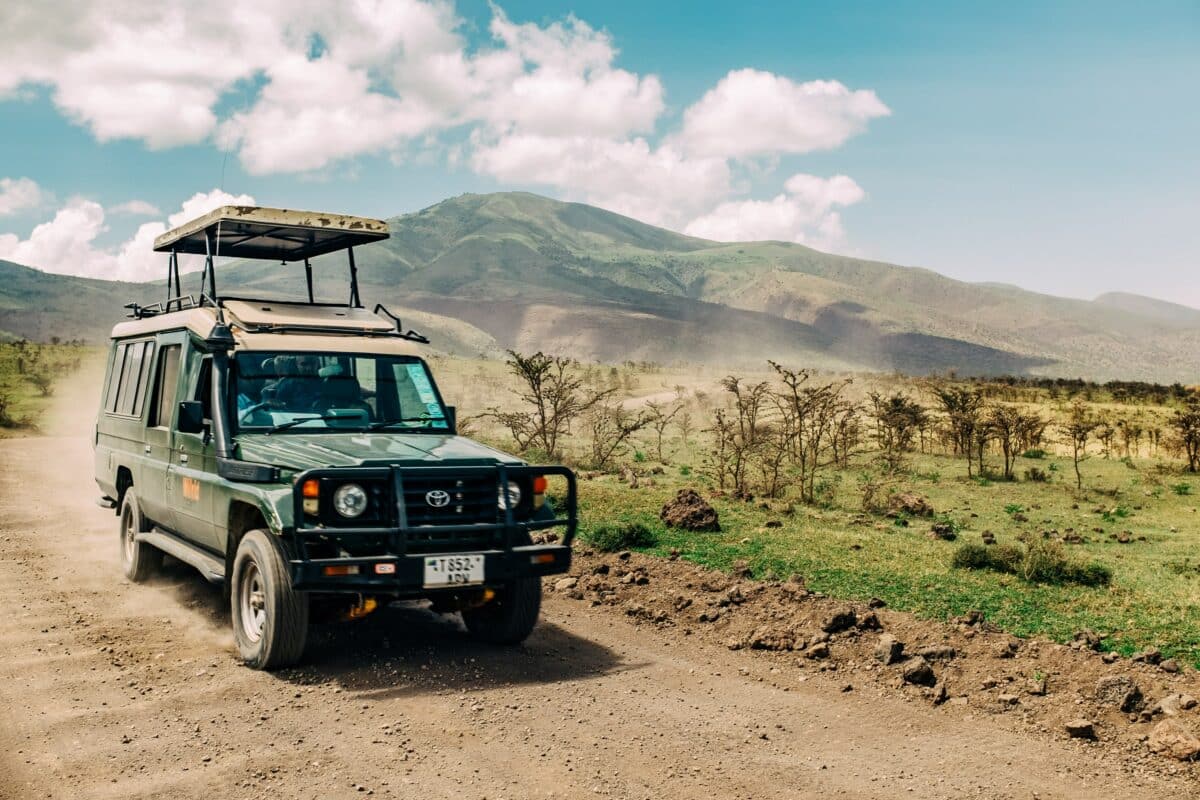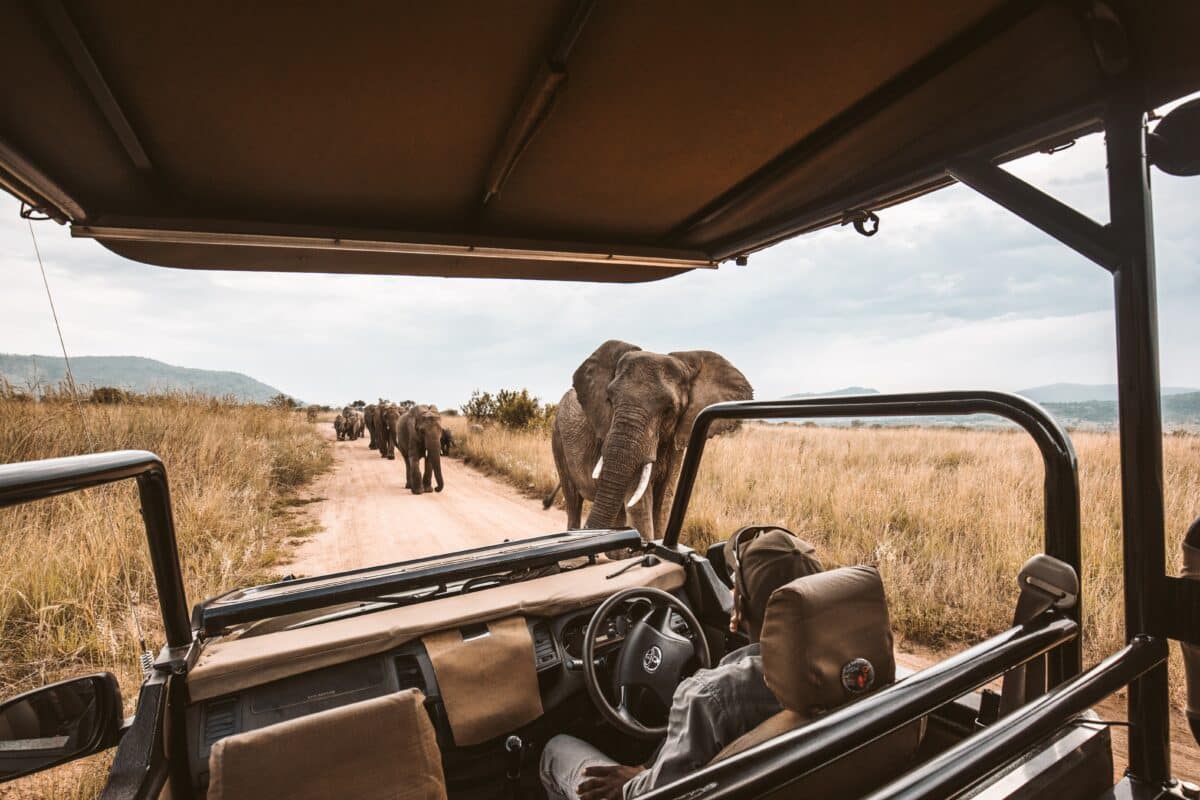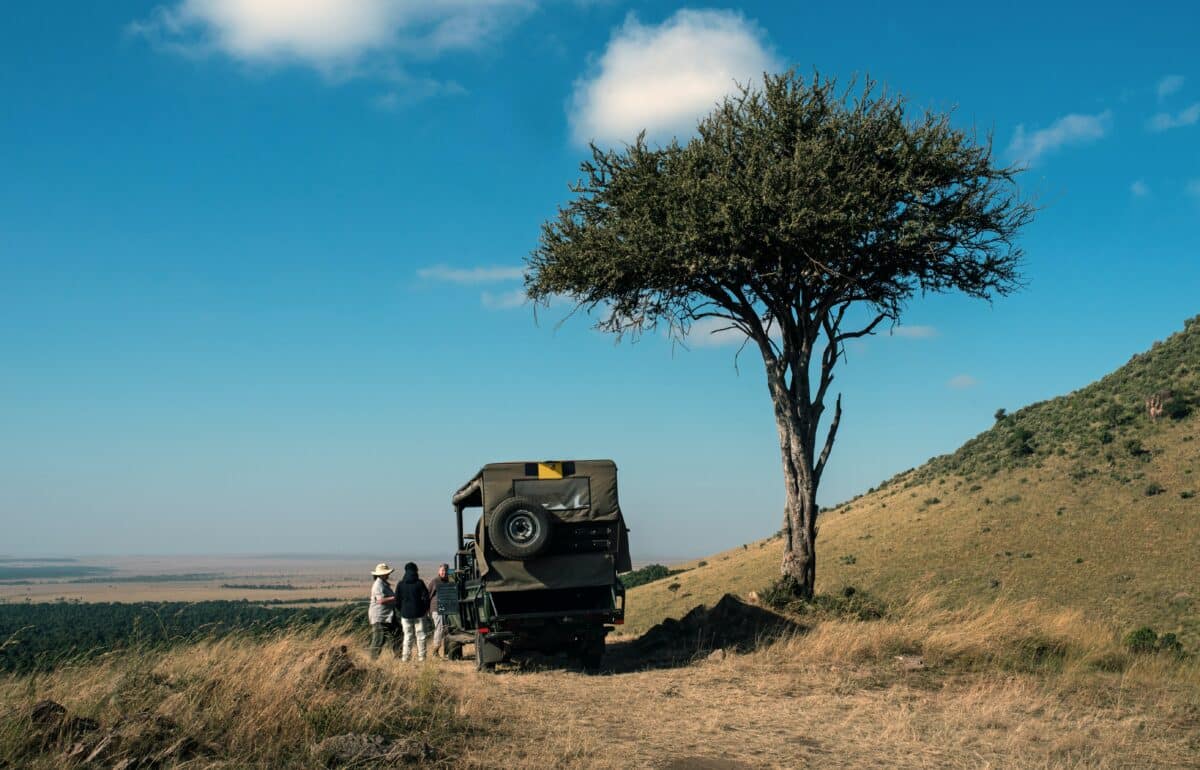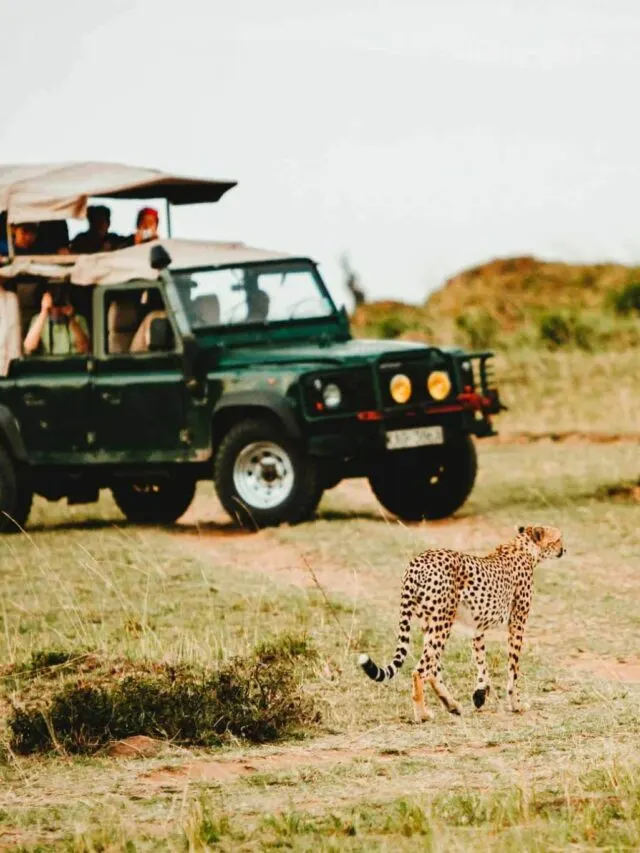Can’t decide where you want to start your next (or first) safari in Africa? We collected the top 10 safari parks in Africa to see wild African animals in their natural habitat. If you want to know what to be on the lookout for, read our article on the top 10 safari animals you can spot on your travels!

There’s always more to explore so feel free to check out our article on the top 10 countries for safaris! For some Safari fun, you can check our blog post on how a Family Safari completely erupted into chaos!
Read ahead or jump to any section that interests you:
Key points
| Rank | Safari Park | Country | Notable Features |
|---|---|---|---|
| 10 | Amboseli National Park | Kenya | Spectacular views of Mount Kilimanjaro, elephants, and diverse wildlife |
| 9 | Addo Elephant National Park | South Africa | Abundant elephants, lions, black rhinos, and a coastal section known as the “Big 7 |
| 8 | Etosha National Park | Namibia | Iconic landscapes, and abundant wildlife, including lions, elephants, and rhinos |
| 7 | Tarangire National Park | Tanzania | Underrated park with large elephant herds, baobab trees, and wildlife along the Tarangire River |
| 6 | Chobe National Park | Botswana | Known as the “Land of the Giants” due to its large elephant population and diverse wildlife |
| 5 | South Luangwa National Park | Zambia | Unspoiled bush landscape, night safaris, and home to unique endemic species |
| 4 | Kruger National Park | South Africa | One of the largest parks with diverse wildlife, including rare species like wild dogs |
| 3 | Ngorongoro Nature Reserve | Tanzania | Stunning scenery, high predator density, and a safari through the Ngorongoro Crater |
| 2 | Serengeti National Park | Tanzania | Famous for diverse fauna and the annual wildebeest migration |
| 1 | Masai Mara Nature Reserve | Kenya | Iconic landscapes, abundant wildlife, including lions, elephants, and rhinos |
Introduction

A safari (Swahili: journey) in one of Africa’s national parks is an exciting thing: many people can observe a larger number of wild animals and even have the opportunity to see the famous Big 5 of Africa.
The focus is on the savannah and bush landscapes, where savannah elephants, lions, buffalos, and other well-known wild animals feel at home.
Whether it’s Africa for the first time or safari connoisseurs, there should be something for everyone. And it attracts attention: There is no best destination in Africa, but there are the best destinations.
So, where should the next safari lead?
10th place: Amboseli National Park, Kenya
Where else can wild animals be observed with one of the most famous mountains on earth as a backdrop? The Amboseli National Park at the foot of Kilimanjaro in Tanzania serves both as a postcard motif for Africa and as a photographic object. Giraffes, elephants, and all sorts of other wild animals strut in front of the snow-covered summit of the “Kili” and give great photo motives.
Ancient elephants still live in the park. This allows visitors to observe the almost intact social behavior of the pachyderms in their herds.
The Kilimanjaro usually wraps itself in thick clouds during the day. The chances of seeing it are best in the morning and evening.
9th place: Addo Elephant National Park, South Africa
Number 9 on the top 10 safari parks in Africa is Addo. Known for, as the name suggests, its elephants, the Addo is more than a convenient destination near South Africa’s Garden Route. The park is home to lions again after a resettlement program; black rhinos and leopards are also found here. Due to the extension to the south, the coast with its sharks and whales is also part of the park, which now advertises with the “Big 7.
In conclusion, the park is ideal for exploring with your own (rental) car. Please make sure to ask in advance what you have to consider for the self-drive safari.
In addition, holidaymakers in their cars should ensure they do not run over pill turners (African dung beetles), hundreds of which run across the roads depending on the weather.
8th Place: Etosha National Park, Namibia
Namibia’s most important park is home to countless wildlife, including the white and black rhino which are critically endangered, something you can read more about in one of our other articles about these ancient and disappearing creatures. There are also several predatory cat species and many antelopes. “Etosha” means “big white square,” which describes the landscape well. The vegetation is extremely sparse; in the dry season, many animals gather at artificial waterholes.
In the dry season, many animals can easily be observed at the park water holes and camps. 114 different species of mammals live in the park.
Every coin has two sides: The park is completely fenced in and cuts the animals off their original routes in search of water in the Kuene region. The waterholes are not comparable to the actual environment and natural migration behavior for true lovers.
7th place: Tarangire National Park, Tanzania
The Tarangire National Park is one of the most underestimated parts of the continent. Many visitors only make a short stop at the Serengeti or do not even include the national park in their travel plans. But the park is home to large herds of elephants and many other species in a remarkable landscape of baobab trees.
The park is known for its elephant herds, which run through a prehistoric landscape along the Tarangire River.
The park is home to the tsetse fly, which transmits sleeping sickness. Visitors should urgently pay attention to consistent protection.
6th place: Chobe National Park, Botswana
“Land of the Giants” is written on the sign at the park entrance and already announces the park’s main attraction: Elephants, one of the savannah’s most social creatures. Between 80,000 and 100,000 pachyderms are estimated to live in the park and adjacent areas, where they migrate depending on the season.
Botswana pursues an exemplary animal and species conservation policy and no longer kills elephants if they become too numerous for the ecosystem. Instead, fences were dismantled to create more space for the animals. Kaffir buffalos and warthogs are also common. As a result, always check the weather forecast before you go.
A safari with a boat on the Chobe River creates an experience that holiday-makers surely won’t forget easily.
During the high season, the Chobe River can be very narrow.
5th place: South Luangwa National Park, Zambia
On the Luangwa River, the wilderness awaits no fences, and no radios to communicate with the rangers. Those who travel to the South Luangwa National Park will experience the bush unadorned, without much traffic and wild. It is not uncommon for your own jeep to be the only one at a spectacular sighting, giving visitors more time and peace to enjoy the encounter with the animals. Night safaris and bushwalks, i.e. safaris on foot, are allowed in the national park.
Pure wilderness. The park is known for its hippos and leopards. Many camps are not fenced and often wild animals run through the lodges. The park is also home to numerous endemic species and subspecies, i.e. animals that can only be found here. Sometimes you can even see the endangered Pangolins and the even more threatened Rhinos. Two species of Animals we explore in more detail in another article.
These include the Cookson gnu, the Crawshay zebra and the Thorneycroft giraffe.
The season plays an important role in the South Luangwa National Park. While in the dry season, many large wild animals gather at the water and are so easy to discover, during the rainy season bird lovers get their money’s worth.
4th place: Kruger National Park, South Africa
For most vacationers, the Kruger National Park is the first safari experience in the African bush. It is one of the largest national parks on the continent and is home to a wide variety of wildlife. In contrast to the open savannahs in East Africa, the landscape is bushy and the animals are harder to spot.
This may be described as the best South African Safari.
In the Kruger National Park live some very rare animal species like wild dogs. Another animal worth further exploration in another one of our articles.
The good infrastructure, the developed roads and the fences around the national park make it clear that the park is used and marketed commercially.
This partly causes a lot of traffic in the park and has at some corners only little to do with the real wilderness feeling.
3rd place: Ngorongoro Nature Reserve, Tanzania
Lioness in Ngorongoro Reserve, Tanzania
While driving over the edge of the burglary crater into the nature reserve, visitors can rarely suppress the “wow” that involuntarily comes over their lips. The view can take your breath away. The safari through the crater, which has the highest predator density in Africa, becomes the photographic highlight of many African journeys.
The wildlife hike through Masai Mara and Serengeti also touches on the protection of the wildlife.
Overall, the high density of animals naturally attracts many visitors and some have the feeling of driving through an open-air zoo.
Some of the jeeps obstruct the way of the animals or hinder cats of prey during the hunt. Tell your driver that you don’t approve of such behavior.
2nd place: Serengeti National Park, Tanzania
Hardly any other national park in Africa is as famous as the Serengeti. This is of course due to the diverse fauna and one of the largest animal migrations in the world.
On the other hand, the Serengeti is almost always threatened: Many people have an interest in the place and in the fertile savannah, on which millions of wild animals cavort and planned large-scale projects would probably mean the end of the national park. The battle for the Serengeti has been fought for decades and culminated in the documentary “Serengeti Must not Die” by Michael Grzimek and his father Bernhard in the 1950s.
The migration of wild animals, where millions of wildebeests, zebras and antelopes travel in a large circle through the Serengeti and the adjoining Masai Mara in Kenya during the course of the year. This is known also as one of the great wildebeest migrations, a topic you can do further reading on with another one of our articles.
The Serengeti is exposed to constant threats. The plans to build a highway through the area are not over yet. There are also frequent conflicts between wildlife and humans.
In addition, organizations are now warning that too many tourists are coming to the park. It is best to drive in the low season and avoid facilities that require a lot of water (swimming pools etc.).
1st Place: Masai Mara Nature Reserve, Kenya
Number one on the top 10 safari parks in Africa list! When tears shoot into the eyes of the viewers of a lion documentary because the pictures are so overwhelming, the reportage is mostly shot in the Masai Mara (or Maasai Mara).
Wide landscape with green hills as far as the eye can see. The view is interrupted only by Wildebeest, zebras, giraffes, Elephants, antelopes, lions, hyenas… The Masai Mara could pass for an African cliché if it were not real.
Word has got around of course that the Masai Mara is a paradise on earth. It is therefore frequently overcrowded and the many cars already have an influence on the behavior of the wild animals. Some cars leave the tracks in search of the best view. If this happens to you, it’s best to tell the driver that you don’t want them to.
The park also serves as a Rhino sanctuary and is home to some 60 white and black rhinos, who are guarded around the clock by armed rangers. An absolute must for rhino fans, who are almost guaranteed to meet some of the animals here.
The impressive Murchison waterfall, where the Victoria Nile plunges over 43 meters into the depths, is also a must-see. The park is home to the endangered Rothschild Giraffes (also Uganda giraffe or Nubian giraffe). To the south of the park is the Budongo chimpanzee forest.
The park is in some places tsetse fly high area. Be sure to take care to protect yourself against insects.
When to go on a Safari
The best time is always present, but if you are looking for the most enjoyment from your trip, the best time to go is from July through October, when the animals are easy to find and in substantial numbers. However, deciding when to go on a safari depends on what country you want to visit and when you can plan your trip. As well as the type of wildlife you hope to encounter.
The best months for an African safari are therefore varied.
What to pack/ best luggage for African safari

Essential Safari Packing List:
- T-shirt, shirt, or blouse with long sleeves and collars for sun and mosquito protection.
- Fleece or warm jacket.
- Safari trousers, preferably those with zip-off knees.
- Comfortable walking shoes (or boots) and socks.
- Hat.
Above and beyond the comfortable basics, there are niche items that could enhance your experience on safari. We’ve researched the best of these items to take with you.
Best insect repellent for African safari: Natrapel 8-Hour insect repellent. This is a CDC-recommended product based on 20% Picaridin formula and is DEET FREE. It is safe to spray on your skin and clothing.
Best binoculars for African safari: Celestron 71347 Outland x | 10×25 | Best compact Binoculars for Travel.
Best camera for African safari: Best-buy cameras for safari in Africa: The Canon EOS Rebel series. Often you can get a kit (camera + lenses + accessories). Best for traveling and easy shots.
Best shoes for an African safari: light trail shoes and hybrid shoes/sandals (Keen, Teva, Merrel, North Face, HiTec, Garmont, Salomon etc) are adequate for regular travel and normal safari conditions. Even fly-camping trips and walking trails on fairly rough terrain don’t warrant hiking boots when conditions are dry.
It is important to find out what you need for specific areas as well as administrative documents and permits.
Summary of Top 10 Safari Parks in Africa
The landscape is very bushy and visitors often only see the animals when they are standing directly in front of or next to the car. Slow driving is therefore all the more important.
How did you like the article on the top 10 safari parks in Africa? In conclusion, we hope to give you some ideas and inspirations on the best African safari tours, animal encounters and holiday trips.
- Masai Mara Nature Reserve, Kenya – Overcrowded but abundant wildlife, including rhinos.
- Serengeti National Park, Tanzania – Famous for the great wildebeest migration.
- Ngorongoro Nature Reserve, Tanzania – High predator density, popular tourist destination.
- Kruger National Park, South Africa – Large park with diverse wildlife, commercialized.
- South Luangwa National Park, Zambia – Unspoiled wilderness, known for hippos and leopards.
- Chobe National Park, Botswana – Land of the Giants, home to a large elephant population.
- Tarangire National Park, Tanzania – This underrated park with large elephant herds and baobab trees.
- Etosha National Park, Namibia – Sparse vegetation, and artificial waterholes attract many animals.
- Addo Elephant National Park, South Africa – Known for elephants, a self-drive safari is recommended.
- Amboseli National Park, Kenya – Elephants near Mount Kilimanjaro, observe intact social behavior.
Safari Tips:
- Optimal time: July to October for increased animal sightings.
- Essential packing: Long-sleeved shirts, hat, fleece, comfortable shoes, and insect repellent.
- Recommended binoculars: Celestron 71347 Outland x | 10×25.
- Ideal camera: Canon EOS Rebel series for safari photography.
- Verify specific requirements, permits, and administrative documents for each park.
Be advised that those are subjective ideas and of course, every safari park, whether big or small can be beautiful and present you with awesome wildlife.
There’s always more to explore so feel free to check out our article on the top 10 countries for safaris!
Frequently Asked Questions (FAQs)
Safari experiences are generally safe, but it’s important to follow guidelines and instructions provided by your guides or tour operators. Wildlife should be observed from a safe distance and never approached or provoked. It’s also recommended to stay within designated areas and camps, especially during night hours. Adhering to these precautions ensures a safe and enjoyable safari experience.
Many safari operators and lodges prioritize sustainability and conservation efforts. They work to minimize the ecological impact by implementing responsible practices such as supporting local communities, conserving natural resources, and participating in wildlife conservation initiatives. When choosing a safari operator, it’s advisable to opt for those with strong environmental ethics and credentials.
Interacting with or touching wildlife is strongly discouraged and, in most cases, prohibited during safaris. The well-being of the animals and the safety of visitors are of utmost importance. Safaris promote responsible wildlife viewing, which involves observing animals from a safe distance and respecting their natural behaviors. Touching or disturbing wildlife can cause stress or potentially dangerous situations for both humans and animals.
Several ways to contribute to conservation efforts during a safari include supporting eco-friendly lodges or tour operators that actively participate in conservation initiatives. Additionally, you can choose to visit parks and reserves that allocate a portion of the entrance fees to conservation projects. It’s also encouraged to learn about and respect local customs, traditions, and wildlife protection regulations while engaging in responsible tourism practices.
- Best Places to See Brown Bears - April 19, 2024
- Animals in Greece - April 19, 2024
- Pangolins: The Complete Guide - April 19, 2024


